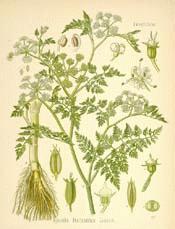

|
Dropwort, Water
(Phellandrium aquaticum printed as
Oenanthe Phellandrium Lamarck)
|
Dropwort, Water
Botanical: Oenanthe phellandrium (LANK.)
Family: N.O. Umbelliferae
---Synonyms---Water Fennel. Horsebane. Phellandrium aquaticum (Linn.).
---Part Used---Fruit.
Oenanthe phellandrium (syn. Phellandrium aquaticum), the Fine-leaved Water Dropwort, known popularly as Water Fennel, is a common British plant in ditches and by the sides of ponds.
It is a biennial, flowering from July to September in its second year of growth.
---Description---The stems are 2 to 3 feet high, very stout at the base, rising from fibrous roots. The leaves are divided into many fine segments, the lower ones submerged. The umbels are smaller than those of O. crocata and are on short stalks, springing either from the forks of the branches or from opposite the leaves.
The rootstock varies in appearance, according to the locality. If growing in deep or running water the rootstock and stem are long and slender; in other districts it is thicker and more erect. The variety that grows in deep running water is often considered a distinct species and is classed under O. fluviatilis.
O. phellandrium is less poisonous than O. crocata, but both produce ill-effects if eaten.
---Constituents---The fruits yield from 1 to 2 1/2 per cent of an ethereal oil, known as Water Fennel Oil, a yellow liquid of strong, pleasant, characteristic odour and burning taste, its specific gravity 0.85 to 0.89, containing as its chief constituent about 80 per cent of the terpene Phellandrene.
---Medicinal Action and Uses---The fruits have been used in chronic pectoral affections such as bronchitis, pulmonary consumption and asthma, also in dyspepsia, intermittent fever, obstinate ulcers, etc. The dose when given in powdered form is 5 or 6 grains to commence with, so repeated as to amount to a drachm in four hours. An alcoholic extract and essence of the fruits has also been recommended as a very valuable and active remedy in the relief of consumption and bronchitis.
In overdoses the fruits produce vertigo, intoxication and other narcotic effects.
Externally applied, the root has sometimes been used as a local remedy in piles. When eaten in mistake, like that of O. crocata, the results have sometimes proved fatal. The symptoms produced are those of irritation of the stomach, failure of circulation and great cerebral disturbance, indicated by giddiness, convulsions and coma.
The fresh leaves are injurious to cattle, producing a kind of paralysis when eaten. When dried, they lose their deleterious properties .
O. fistulosa, the Common Water Dropwort, is found in watery places. This has a mixture of slender and fleshy roots, and bears leaves with only a few narrow segments. It is also poisonous. A peculiar resinous principle, called cenanthin, has been found in this species.
Most of the other species of Oenanthe found both in Great Britain and in the United States are poisonous, although none appear to be as virulent as O. crocata. A few are, however, innocuous, and their roots, especially those of O. pimpinelloides, have been esteemed as food in certain districts. Burnett (Medical Botany) states 'they are replete with a bland farina and have something the flavour of a filbert.'
[Top]
Common Name Index
A MODERN HERBAL Home Page
Bear in mind "A Modern Herbal" was written with the conventional wisdom of the early 1900's. This should be taken into account as some of the information may now be considered inaccurate, or not in accordance with modern medicine.
© Copyright Protected 1995-2004 botanical.com

|

